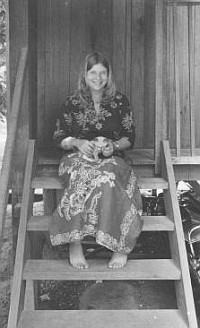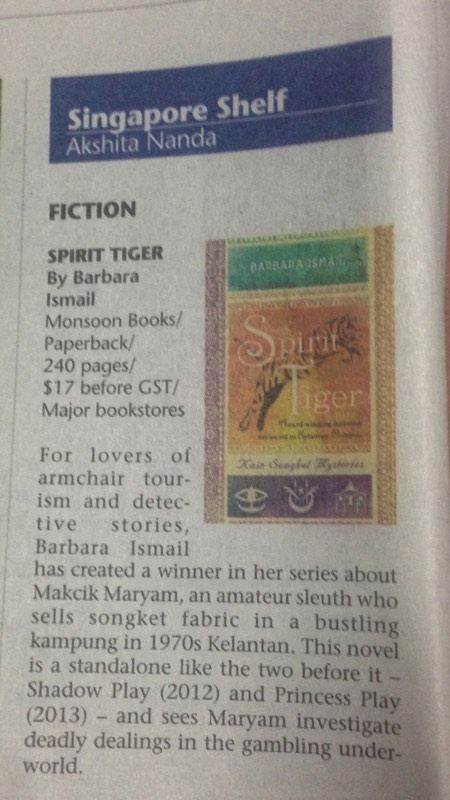The Star - in English
‘Murder’ in Kelantan
By OH ING YEEN
star2@thestar.com.my
Why has an American author set her mystery series in a Malaysian state?
MOST of us who love English language detective stories would be familiar with Western sleuths, like Sir Arthur Conan Doyle’s Sherlock Holmes, Agatha Christie’s Hercule Poirot or Ian Rankin’s Inspector Rebus; and even when they aren’t Western, they tend to be foreign (like Precious Ramotswe, who heads the No.1 Ladies’ Detective Agency in Africa in the series by Scottish author Alexander McCall Smith). But a Kelantanese makcik detective?
That certainly caught my attention when I first heard about Shadow Play.
And if there is such a character, one would expect her to be investigating stolen chickens or vanished, valuable kain songket, right? But no, this gutsy lady is tasked with solving a murder, no less! You see, the new chief of police who is in charge of the case doesn’t understand the local culture and dialect, so Makcik Maryam comes to the rescue – but soon gets more than she bargained for.
The book is the first in the Kain Songket Mysteries series set in Kelantan during the 1970s.
It seems that author Barbara Ismail spent several years in that state in the 1970s and 80s, living in Kampung Dusun and Pengkalan Cepa, and studying wayang Siam (the Kelantanese style of shadow puppetry) and the Kelantanese dialect. The New York native had been inspired by her anthropology professor (and author), Douglas Raybeck, who had conducted field studies in Kelantan.
“He first taught me Malay and I had heard so much about it in his classes, I just had to go!
“I spoke Malay before I arrived, but I learned Kelantanese in Kota Baru – I don’t know if you can really learn Kelantanese outside of Kelantan. Now my Malay accent is totally Kelantanese,” Ismail says in an e-mail interview.
“I loved Kelantan, and the people were so very warm and welcoming. I’ve returned to Kelantan many times, I love it there, and was very sure I wanted my two daughters to know it as well.”
What was the inspiration for Shadow Play and the Kain Songket Mysteries?
“I studied wayang Siam in Kelantan, doing the field work for my dissertation. I love wayang kulit. I found it fascinating from the first time I experienced it in Java, where I studied during my junior year of college. When I saw my first Kelantan wayang siam performance, I was hooked,” she says.
While the foreword makes the usual disclaimer about the characters in the book being fictitious, Ismail did base Maryam on an amalgamation of the women whom she came to know during her stay in Kelantan.
“It’s an acknowledgement of the women I met who dominated the famous Kota Baru market. They were excellent businesswomen, who really took charge.
“Several of my neighbours in Kg Dusun worked in the market selling cloth. I would visit them in the market, and I loved the fabrics.
By OH ING YEEN
star2@thestar.com.my
Why has an American author set her mystery series in a Malaysian state?
MOST of us who love English language detective stories would be familiar with Western sleuths, like Sir Arthur Conan Doyle’s Sherlock Holmes, Agatha Christie’s Hercule Poirot or Ian Rankin’s Inspector Rebus; and even when they aren’t Western, they tend to be foreign (like Precious Ramotswe, who heads the No.1 Ladies’ Detective Agency in Africa in the series by Scottish author Alexander McCall Smith). But a Kelantanese makcik detective?
That certainly caught my attention when I first heard about Shadow Play.
And if there is such a character, one would expect her to be investigating stolen chickens or vanished, valuable kain songket, right? But no, this gutsy lady is tasked with solving a murder, no less! You see, the new chief of police who is in charge of the case doesn’t understand the local culture and dialect, so Makcik Maryam comes to the rescue – but soon gets more than she bargained for.
The book is the first in the Kain Songket Mysteries series set in Kelantan during the 1970s.
It seems that author Barbara Ismail spent several years in that state in the 1970s and 80s, living in Kampung Dusun and Pengkalan Cepa, and studying wayang Siam (the Kelantanese style of shadow puppetry) and the Kelantanese dialect. The New York native had been inspired by her anthropology professor (and author), Douglas Raybeck, who had conducted field studies in Kelantan.
“He first taught me Malay and I had heard so much about it in his classes, I just had to go!
“I spoke Malay before I arrived, but I learned Kelantanese in Kota Baru – I don’t know if you can really learn Kelantanese outside of Kelantan. Now my Malay accent is totally Kelantanese,” Ismail says in an e-mail interview.
“I loved Kelantan, and the people were so very warm and welcoming. I’ve returned to Kelantan many times, I love it there, and was very sure I wanted my two daughters to know it as well.”
What was the inspiration for Shadow Play and the Kain Songket Mysteries?
“I studied wayang Siam in Kelantan, doing the field work for my dissertation. I love wayang kulit. I found it fascinating from the first time I experienced it in Java, where I studied during my junior year of college. When I saw my first Kelantan wayang siam performance, I was hooked,” she says.
While the foreword makes the usual disclaimer about the characters in the book being fictitious, Ismail did base Maryam on an amalgamation of the women whom she came to know during her stay in Kelantan.
“It’s an acknowledgement of the women I met who dominated the famous Kota Baru market. They were excellent businesswomen, who really took charge.
“Several of my neighbours in Kg Dusun worked in the market selling cloth. I would visit them in the market, and I loved the fabrics.

Rustic life: Barbara Ismail in Kelantan in 1977. She spent several years in the state, living in Kampung Dusun and Pengkalan Cepa, studying wayang Siam.

Today, the author resides in the United States. Her Kain Songket Mysteries series is set in Kelantan during the 1970s.
“Makcik Maryam is a combination of several of them, and some of my neighbours in Kota Baru. And my mother’s name is Miriam, so she’s in there, too,” says Ismail, adding that she is still in touch with the woman who inspired the character called Ashikin in Shadow Play.
“My friend and former neighbour Ashikin Mohd Ali and I still talk all the time. We met when she was 12 and I was 24, so we’ve known each other for most of our lives now – I can’t believe it.
“Her little brother, Yi, is the model for Maryam’s youngest. I lived for a year with Ab Malek Jusoh and Wan Hamidah Wan Nawang, and they are the inspiration for some of the nicest people in the book.”
There are currently six books in the series, namely Shadow Play, Princess Play, Songbird, Moon Kite, Western Chanting, and Little Axe. Is there a seventh book in the works?
“I’ll keep writing for as long as I can do it – and people are interested in reading them!” she says.
I am now a fan of the main character Makcik Maryam, what with her take-charge attitude and motherliness that draws people to open up to her.
What I also love is the use of Malay terms and idioms in the story, which adds a wonderful local touch. For those who do not understand Bahasa Malaysia, fret not, as all the terms are explained in a handy glossary. I myself found out that tahi itik, which means duck faeces, is also a type of Kelantanese sweet cake!
“My friend and former neighbour Ashikin Mohd Ali and I still talk all the time. We met when she was 12 and I was 24, so we’ve known each other for most of our lives now – I can’t believe it.
“Her little brother, Yi, is the model for Maryam’s youngest. I lived for a year with Ab Malek Jusoh and Wan Hamidah Wan Nawang, and they are the inspiration for some of the nicest people in the book.”
There are currently six books in the series, namely Shadow Play, Princess Play, Songbird, Moon Kite, Western Chanting, and Little Axe. Is there a seventh book in the works?
“I’ll keep writing for as long as I can do it – and people are interested in reading them!” she says.
I am now a fan of the main character Makcik Maryam, what with her take-charge attitude and motherliness that draws people to open up to her.
What I also love is the use of Malay terms and idioms in the story, which adds a wonderful local touch. For those who do not understand Bahasa Malaysia, fret not, as all the terms are explained in a handy glossary. I myself found out that tahi itik, which means duck faeces, is also a type of Kelantanese sweet cake!

Kosmo! - in Indonesian
Click on any page of the article to see a larger view. If necessary, then click the icon in the upper left of the image to make it even larger.
The Malay Mail
Click to enlarge.


Strait Times
